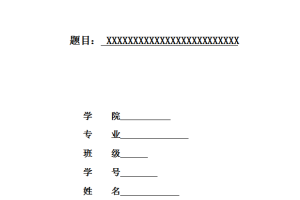摘 要
国内外许多专家和学者们对上市公司绩效评价进行了探讨和研究,形成了绩效评价的各种理论和方法,但是这些理论和方法并非尽善尽美,都各有优势,也各有缺陷,并且这些理论和方法在我国的适用性也受到了诸多质疑。绩效评价已经从最初的单纯评价成本阶段到今天的应用于企业战略的绩效评价阶段,本文正是从国内外绩效评价的发展演变出发,对上市公司绩效评价的理论基础和理论框架进行了重新构建,提出上市公司绩效评价主体是各利益相关者,以企业价值最大化为前提,以为各利益相关者提供决策支持信息为绩效评价目标,对企业、管理者以及员工等客体,在一定原则的基础上进行综合评价。在此理论框架的基础上,并结合对 EVA和平衡计分卡两种绩效评价方法的研究和讨论,分析我国现行上市公司绩效评价存在的问题,并针对问题提出改进建议。
本文主要提出四方面改进建议,一是建立多角度的综合绩效评价体系以满足不同评价主体的不同需求,综合考虑不同利益相关者关注的指标,建立尽量完整的评价系统;二是优化上市公司绩效评价体系的结构,从建立财务指标与非财务指标之间的联系、平衡财务指标和非财务指标、合理设定评价指标权重等几方面提出了改进建议;三是改进上市公司绩效评价指标,应考虑股权资本成本,增加以市值为基础的指标,并对非财务指标进行补充和完善等等;四是建立动态的绩效评价系统,只有一个开放的、可以适时调整的指标评价体系才能适应不断变化和发展的客观环境。
关键词:绩效评价;平衡记分卡; 利益相关者
At home and abroad, many experts and scholars on the performance evaluation of listed companies were discussion and the research, has formed the performance evaluation theories and methods, but these theories and methods are not perfect, and each has advantages, but also have their own defects and the theory and method of applicability in China has also been a lot of questions. Performance evaluation has from the initial pure cost evaluation stage to today’s application in enterprise strategy performance evaluation stage. The purpose of this paper is the development of performance evaluation at home and abroad from the evolution of re construction of the theoretical basis and theoretical framework of performance evaluation of listed companies, a listed company performance evaluation subject is the various stakeholders, on the premise of maximization of enterprise value, so that all stakeholders provide decision support information for performance evaluation target, the object of enterprises, managers and employees, on the basis of certain principles of comprehensive evaluation. On the basis of this theory, combined with the study and discussion of the two kinds of performance evaluation method of EVA and the balanced scorecard card, analysis of the problems existed in our current performance evaluation of listed companies, and puts forward some suggestions for improvement.
This paper put forward four suggestions for improvement, one is the establishment of a comprehensive performance evaluation system of multi angle to meet the different needs of different evaluation subjects, considering the different stakeholders attention index, establish the evaluation system to complete; two is to optimize the structure of listing Corporation’s performance evaluation system, put forward the improvement proposal from the established financial indicators and non – financial indicators, balance between financial and non-financial indicators, a reasonable set of several aspects of evaluation index weight; three is to improve the evaluation index of performance of listing Corporation, should consider the cost of equity capital, increase the market based indicators, and to complement and improve on the non financial index; the four is the establishment of performance evaluation system the only one open, timely adjustment of the evaluation index system to adapt to the changing and development objective Environmental Science。
KEY WORDS: Performance evaluation; Balanced Scorecard; Stakeholders
目 录
ABSTRACT………………………………………………….. 2
1.3主要研究内容和研究方法……………………………….. 8
2上市公司绩效评价的概念和相关理论…………………………… 10
2.1 上市公司绩效评价的理论基础…………………………… 10
2.1.1 委托代理理论………………………………….. 10
2.1.3 价值管理理论………………………………….. 11
2.2 上市公司绩效评价体系的理论框架……………………….. 12
2.2.1上市公司绩效评价目标……………………………. 12
2.2.2 上市公司绩效评价指标…………………………… 13
3基于 EVA 的上市公司绩效评价……………………………….. 14
3.1 EVA 的基本理论……………………………………… 14
3.1.1 EVA 的基本原理……………………………….. 14
3.1.2 EVA 绩效评价体系的内容…………………………. 15
3.2 EVA 绩效评价的优点及局限性………………………….. 16
3.2.1 EVA 绩效评价体系的优点…………………………. 16
3.2.2 EVA 的局限性………………………………….. 17
3.3EVA 在我国上市公司绩效评价中的应用…………………….. 18
4我国上市公司绩效评价的现状及存在的问题分析………………….. 19
4.1 我国现行的绩效评价方法………………………………. 19
4.1.1 国有资本金绩效评价…………………………….. 19
4.1.2 中央企业综合绩效评价…………………………… 21
4.1.3 其他绩效评价方法………………………………. 23
4.2我国上市公司绩效评价存在的问题……………………….. 23
4.2.1 现有绩效评价体系不能满足不同利益相关者的需要……… 24
4.2.2 指标权重的设置缺乏科学合理性……………………. 24
4.2.3 绩效评价指标之间缺乏内在联系……………………. 25
4.2.4 在指标计算上未考虑股权资本成本………………….. 25
4.2.5 缺少以市值为基础的绩效评价指标………………….. 26
5对我国上市公司绩效评价的改进建议…………………………… 26
5.1 建立多角度的综合绩效评价体系…………………………. 26
5.2优化上市公司绩效评价体系的结构……………………….. 27
5.2.1 建立财务指标与非财务指标之间的联系………………. 27
5.2.2平衡财务指标和非财务指标………………………… 27
5.2.3合理设定评价指标权重……………………………. 28
5.3 改进上市公司绩效评价指标…………………………….. 29
5.3.1 考虑股权资本成本………………………………. 29
5.3.2增加以股票市值为基础的指标………………………. 29
5.3.3 进一步完善非财务指标…………………………… 30





